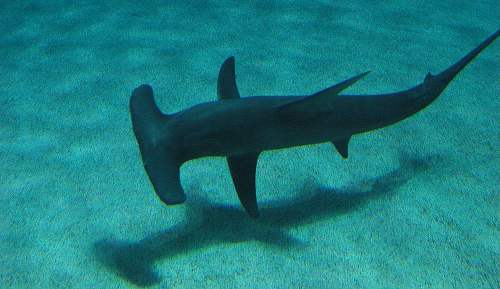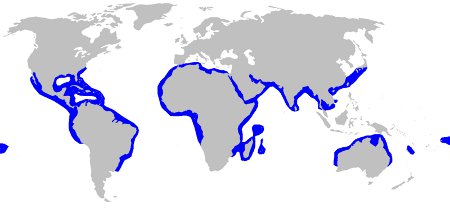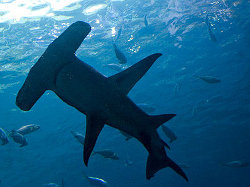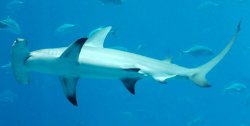Great Hammerhead Shark
Sphyrna mokorran

|
The Great Hammerhead Shark can easily be distinguished from other members of the hammerhead family by the size and shape of its head. The hammer, or cephalofoil, is much larger with a fairly straight leading edge and a notch in the centre. The cephalofoil in juvenile sharks is much rounder than it is in adults. This is the largest shark in the Hammerhead family. Though it rarely attacks humans, it can be inquisitive around divers and should be treated with respect. |
|
It is a large shark and will, quite rightly, defend itself if provoked or threatened.
Unlike some members of the family, great hammerheads are solitary and do not swim in schools.
Size
Pups range from 50 to 70cm at birth. Adult males average about 235 - 270cm while females get to about 250 - 300cm though they can be much larger. The largest recorded great hammerhead was 610cm.
Colouring
Dark olive to greenish or greyish brown with a white underside.
Fins
The first dorsal fin is strongly sickle shaped, large and high. The second dorsal fin is also high but is much smaller than the first. The pelvic fins are relatively large and there is a strongly curved anal fin present.
The caudal fin has a long upper lobe and a shorter lower lobe.
Teeth
The teeth are broadly triangular with strongly serrated edges.
Diet
Their preferred food seems to be stingrays, though they eat a wide variety of prey. Their diet includes cephalopods, crustaceans, fish and other sharks. They are known to be cannibalistic.
Their sense of smell and their enhanced electromagnetic senses help them to easily locate prey buried in the sand. Their mouth, situated on the underside of the head, lends itself to bottom feeding.
Reproduction
They are yolk sac placental viviparous. The number of pups in a litter can vary from as few as 6 to more than 50. The gestation period is around 11 months and they breed every two years.
Distribution
The great hammerhead is found in tropical seas worldwide. They come close inshore as well as well out into the open ocean. They're happy in depths from as shallow as 1m to as deep as about 80m. They migrate to cooler waters in the summer months.
Great Hammerhead Shark Distribution Map

Return to Hammerhead Sharks from Great Hammerhead Shark
Classification
Phylum: Chordata
Class: Chondrichthyes
Subclass: Elsamobranchii
Order: Carcharhiniformes
Family: Sphyrnidae
Genus: Sphyrna
Species: mokorran

Great Hammerhead Shark

Great Hammerhead
Recent Articles
-
Thresher Sharks
Aug 27, 14 10:51 AM
Thresher sharks are unmistakable with that huge upper lobe on the caudal fin. Let's find out more about them. -
Sharkwater
Aug 14, 14 12:42 PM
Sharkwater is a documentary by Rob Stewart highlighting the plight of the sharks in our oceans. -
Natural Cleaners
Aug 13, 14 08:57 AM
Natural cleaners and homemade skincare products are not only better for the environment, they're better for you and your family.
